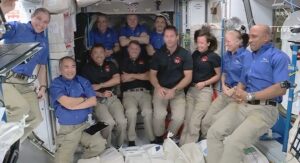Eastern. The four Crew-2 astronauts joined their seven colleagues on the station about two and a half hours later.
Endeavour, which also flew the Demo-2 mission to the station last summer, had a largely trouble-free flight to the ISS. The only issue was external to the spacecraft: controllers asked the crew to get back into their suits and close their visors several hours after launch as a precaution when a piece of space debris was projected to pass close to the spacecraft. The debris passed the spacecraft around 1:45 p.m. Eastern April 23 without incident, and the Crew Dragon did not maneuver to avoid the object, which NASA did not identify.
“It is awesome to see the 11 of you on station,” Steve Jurczyk, NASA acting administrator, said in a brief ceremony shortly after the hatches opened. “I’m really excited this for this new era for ISS.”
With the arrival of Crew-2, the station has 11 people on board for the first time since the STS-134 shuttle mission in May 2011, when the five people on that mission joined the six people on the station who arrived on two Soyuz spacecraft. Here, two Crew Dragon spacecraft transported eight astronauts to the station while a Soyuz transported the other three.
“There’s a number of things you have to do” to support that additional crew, said Joel Montalbano, NASA ISS program manager, at an April 20 briefing about the Crew-2 mission. That includes additional consumables and increasing the capability of the station’s life support systems, as well as temporary sleeping arrangements for the additional astronauts.
That expanded crew size is temporary, as the Crew Dragon Resilience spacecraft will return the four Crew-1 astronauts to Earth on April 28. The spacecraft will undock at 7:05 a.m. Eastern and splash down in the Gulf of Mexico south of Tallahassee, Florida, at 12:40 p.m. Eastern.



